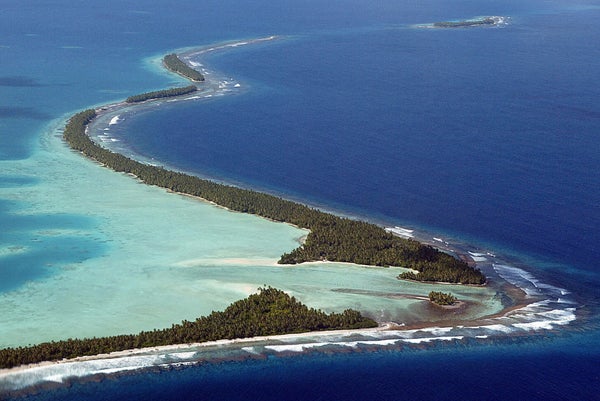Editor’s note: The Obama administration announced on January 17, 2017, that it would give a second payment of $500 million to the Green Climate Fund, which brings the U.S.’s total contribution to $1 billion. The announcement comes just days before President-elect Donald Trump enters office
Developing countries need an almost incomprehensible amount of money—likely trillions of dollars—to help them mitigate and adapt to climate change. The U.S. and other wealthy nations, seen as the main polluters, have agreed to pitch in. That is why the United Nations created the Green Climate Fund, which is now the largest multinational cash pool for financing climate action in developing countries. So far about $10 billion has been pledged, with the U.S. alone promising $3 billion—but with President-elect Donald Trump heading into office, there is now a chance developing countries will not get as much help as they were promised.
Trump has called global warming a hoax and has said he would withdraw the U.S. from the landmark 2015 Paris agreement on climate (although he subsequently toldThe New York Times he is keeping an “open mind” on these issues). In Trump’s “Contract with the American Voter”—his action plan for his first 100 days in office—he singled out U.S. financial contributions to U.N. climate change programs, saying he would “cancel” payments within months after he enters office. That could potentially take a large chunk of funding out of the Green Climate Fund (GCF), because the U.S. has promised the largest contribution of all the contributing nations—and has so far delivered only a small portion of its pledged funds. “They didn’t talk about it at the last [Green Climate Fund] meeting,” says Karen Orenstein, deputy director of the Economic Policy Program at Friends of the Earth. “But it’s clearly the elephant in the room.”
On supporting science journalism
If you're enjoying this article, consider supporting our award-winning journalism by subscribing. By purchasing a subscription you are helping to ensure the future of impactful stories about the discoveries and ideas shaping our world today.
The U.N. established the GCF at its 2010 global climate talks in Cancún, and the fund is one of the main ways to distribute financial support for climate action under the Paris agreement and the U.N. Framework Convention on Climate Change. Based in Songdo, South Korea, the GCF is run by a 24-member board of representatives from developed and developing countries. It works roughly like this: Half of the fund is supposed to go toward climate-mitigation efforts like green energy programs, and the rest toward adaptation efforts like building floodproof infrastructure. Public or private entities can contribute (although only public sources have promised funds so far); the board accepts government or business proposals for projects in developing countries; then the board distributes funds to projects it believes will “support a paradigm shift in the global response to climate change,” according to its Web site.
The GCF received its first pledges in 2014—a total of $10.3 billion—with the money coming mostly from developed countries, but also a handful of developing ones such as Mexico and Chile. Those pledges count toward the $100 billion a year that rich countries have promised to developing countries by 2020 to combat climate change, and much of that sum is expected to move through the GCF. “Developed countries knew they had to make pledges, and make [the GCF] a reasonable-sized fund,” says Matthew Kotchen, a professor of economics at Yale University, who previously represented the U.S. on the GCF board. “Otherwise developing countries would say, ‘You’re not making good on your promise, so why should we commit to reducing our emissions?’”

Credit: Amanda Montañez; Source: Green Climate Fund
In November 2015 the GCF approved a total of $168 million toward its first eight proposals including an urban water supply and wastewater management program in Fiji as well as a project to restore wetlands in Peru. The board has now green-lighted 35 projects totaling $1.5 billion. As of last month, countries had only handed in around $2.6 billionof the overall $10.3 billion pledged.(Currency conversions are based on rates as of January 6, 2017.) A few countries have met their pledges with lump sums whereas others such as the U.S. are paying installments over a period of years—hence the relatively low figure turned in to date.
That arrangement may now create a major setback for the GCF. So far the U.S. has paid only $500 million of its $3-billion pledge—and with Trump poised to enter office in just days, many fear the rest of the money will not come through. Trump has promised to “cancel billions in payments to U.N. climate change programs” within his first 100 days as president. If he has his eye on the GCF, he could work with Congress to ensure the fund does not see another penny—stripping away about a quarter of the GCF’s initial planned funding. The Trump team did not respond to a request for comment on the U.S.’s pledge to the GCF.
Withdrawing U.S. funding would deal a big blow to the fund. “If the money doesn’t come in from countries, then you might have a situation where you have projects that don’t get funded—that’s the danger,” says Niranjali Amerasinghe, a climate finance expert at the World Resources Institute, a global research organization.Of course, there’s no telling what Trump will actually do once he’s president, Orenstein notes. “You never know what might happen,” she says. “But it doesn’t look good.”
